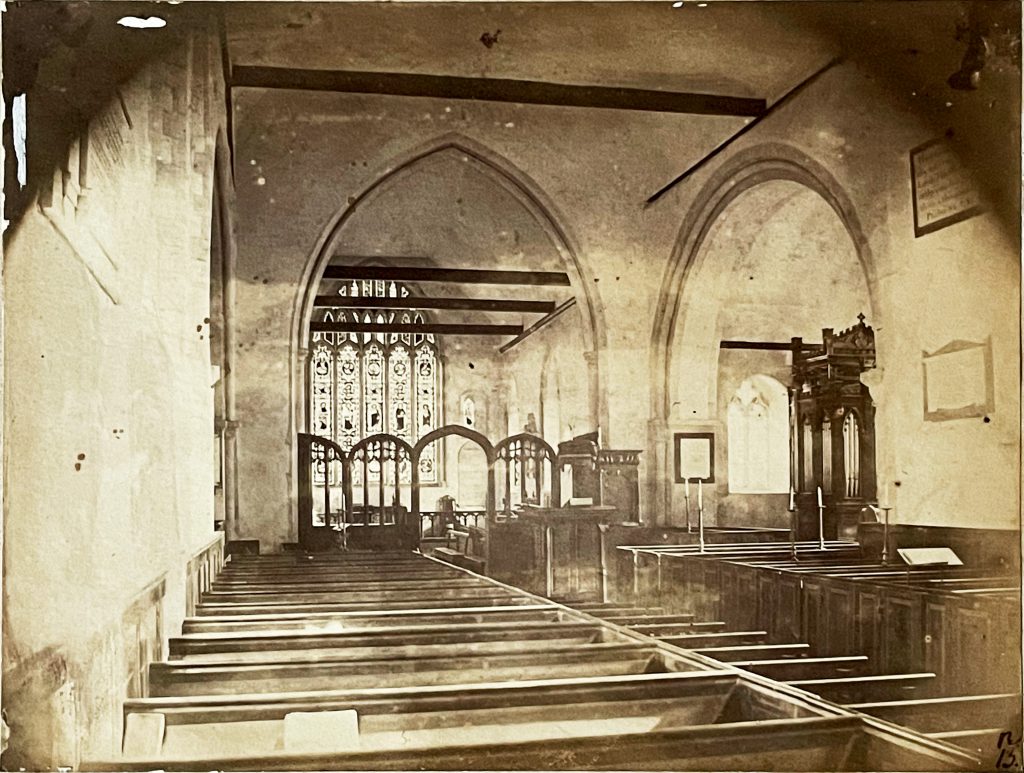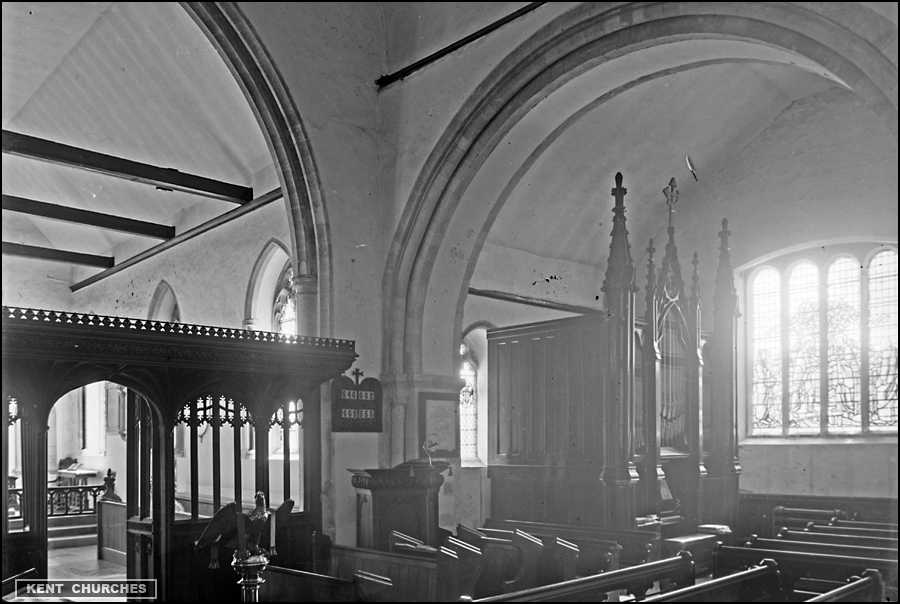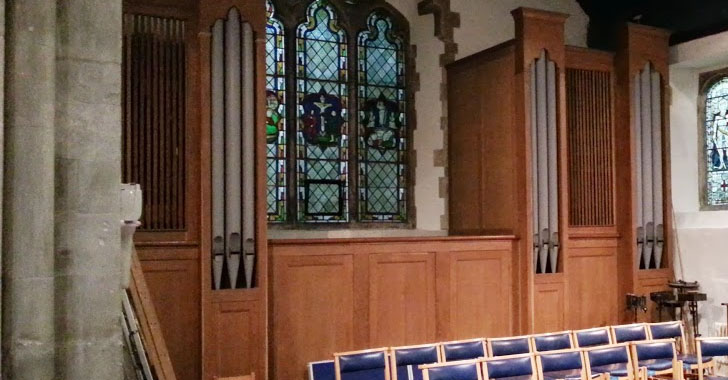The first organ was purchased for the parish by the Reverend John White, sometime in the middle of the nineteenth century – the first record of a salary being paid to an organist is in 1843, when Mr John Smith was paid £5 for playing the organ. The details of this instrument are unclear, most likely a single manual instrument built, according to the National Pipe Organ Register (www.npor.org.uk), by James Eagles, an organ builder based in London between c. 1840 and 1864. Around 1879 this organ was either replaced or rebuilt by J.W. Walker, also based in London. At this time the organist’s salary was increased to £20 a year (paid quarterly at Easter, Lady Day, Michaelmas and Christmas) and 16/- a year paid to the organ blower.
The specification of the Walker organ in the south transept at the beginning of the twentieth century was as follows:
| Great | Compass CC – F, 54 notes | |
|---|---|---|
| Open Diapason | 8′ | Metal from C; lowest octave wood |
| Keraulophon | 8′ | T.C. Metal |
| Clarabella | 8′ | T.C. Wood |
| Stopped Bass | 8′ | Bottom 12 notes only; wood |
| Principal | 4′ | Metal |
| Flute | 4′ | Wood |
| Fifteenth | 2′ | Metal |
| Cornopean | 8′ | T.C. Metal |
| Swell to Great | ||
| Swell | Compass T.C. to F, 42 notes | |
| Bourdon | 16′ | Wood and metal |
| Open Diapason | 8′ | Metal |
| Stopped Diapason | 8′ | Wood |
| Principal | 4′ | Metal |
| Trumpet | 8′ | Metal |
| Pedal | Compass CC – G, 20 notes | |
| Bourdon | 16′ | Wood |
| Great to Pedal |

In 1902, Brownes tended a quote to rebuild and enlarge the organ with the following specification:
| Great | Compass CC – A, 58 notes | |
|---|---|---|
| Open Diapason | 8′ | Metal |
| Clarabella | 8′ | Wood |
| Dulciana | 8′ | Metal; Grooved bass |
| Principal | 4′ | Metal |
| Flute | 4′ | Wood |
| Fifteenth | 2′ | Metal |
| Swell to Great | ||
| Octave Swell to Great | ||
| Swell | Compass CC to A, 58 notes | |
| Leiblich Bourdon | 16′ | Wood and metal |
| Open Diapason | 8′ | Metal and metal |
| Stopped Diapason | 8′ | Wood |
| Salicional | 8′ | Metal |
| Voix Celestes | 8′ | T.C. Metal |
| Principal | 4′ | Metal |
| Piccolo | 2′ | Metal |
| Cornopean | 8′ | Metal |
| Oboe | 8′ | Metal |
| Swell Octave | ||
| Pedal | Compass CC – F, 30 notes | |
| Bourdon | 16′ | Wood |
| Flute Bass | 8′ | Wood |
| Great to Pedal | ||
| Swell to Pedal |
Two combination pedals to Great
Two combination pedals to Swell
Tubular pneumatic action
This was to be built using the existing pipework with new where necessary, and using the exiting casework, again adapted where necessary. The cost of the quote was Three hundred and fifty pounds. There was also a second scheme proposed to have the organ placed ‘on pillars at the west end’ (so even over a hundred years ago there was dissatisfaction with the placing of the organ in the transepts and the resulting balance in the nave!) with the addition of thumb pistons in place of combination pedals. The cost of this second scheme was Four hundred and twenty-five pounds.
Sadly it seems that both of these schemes were beyond the means of the congregation of St Stephen’s at that time, and a much reduced instrument was ordered for two-hundred pounds: “an organ of two manuals and pedal, containing 13 sounding stops, 4 couplers, 4 comp. ped, in Pine Case…” (Brownes Ledger, page 611). An additional three pounds was paid for “fitting sheet zinc to wall [as a] protection against damp” (ibid.) and two pounds for a pitch pine seat.
The resulting instrument’s specification was as follows:
| Great | Compass CC – G, 56 notes | |
|---|---|---|
| Open Diapason | 8′ | Metal; Wood bottom octave |
| Leiblich Gedact | 8′ | Metal; Wood bottom octave |
| Dulciana | 8′ | Metal; Grooved bass |
| Principal | 4′ | Metal |
| Flute | 4′ | Wood |
| Swell to Great | ||
| Swell | Compass CC to G, 56 notes | |
| Violin Diapason | 8′ | Metal, wood bottom octave |
| Stopped Diapason | 8′ | Wood |
| Salicional | 8′ | Metal |
| Voix Celestes | 8′ | T.C. Metal |
| Gemshorn | 4′ | Metal |
| Piccolo | 2′ | Metal |
| Oboe | 8′ | Metal |
| Swell Octave | ||
| Swell Sub-Octave | ||
| Pedal | Compass CC – F, 30 notes | |
| Bourdon | 16′ | Wood |
| Great to Pedal | ||
| Swell to Pedal |
Two combination pedals to Great
Two combination pedals to Swell
Tubular pneumatic action

In 1964 the mechanical side of the instrument was failing, and so the tubular pneumatic action was replaced with new direct electric action soundboards by F. H. Browne & Sons. A new case was constructed in the north transept either side of the large central window. Little change was made to the tonal resources of the organ, save for the replacement of the Vox Celeste with a Twelfth on the Swell, and a two-rank mixture (15.19) added to top the Great chorus. The range of pedal stops was increased through the use of the extension principle, all being taken from the same rank of Bourdon pipes.
F. H. Browne and Sons, 1964
| Great | Compass CC-G, 56 notes | |
|---|---|---|
| Open Diapason | 8′ | Metal, Bottom octave in case front |
| Leiblich Gedackt | 8′ | Metal, bottom octave wood |
| Dulciana | 8′ | Metal, bottom octave from L.G. |
| Principal | 4′ | Metal |
| Wald Flute | 4′ | Wood |
| Mixture II | 15.19 | Metal |
| Swell to Great | 8′ | |
| Swell Octave to Great | 4′ | |
| Swell | Compass CC-G, 56 notes | |
| Geigen Diapason | 8′ | Metal, bottom octave wood |
| Stopped Diapason | 8′ | Wood |
| Salicional | 8′ | Metal, bottom octave from S.D. |
| Gemshorn | 4′ | Metal |
| Twelfth | 2 2/3′ | Metal |
| Fifteenth | 2′ | Metal |
| Oboe | 8′ | Metal |
| Swell Sub Octave | 16′ | |
| Swell Octave | 4′ | |
| Pedal | Compass CC-F, 30 notes | |
| Bourdon | 16′ | Wood |
| Quint | 10 2/3′ | Extension |
| Flute Bass | 8′ | Extension |
| Octave Quint | 5 1/3′ | Extension |
| Octave Flute | 4′ | Extension |
| Great to Pedal | ||
| Swell to Pedal | ||
| Swell Octave to Pedal |
Balanced Swell Pedal.
4 divisional thumb pistons to Great and Swell.
Swell to Great and Great to Pedal reversable thumb piston.
Great to Pedal reversable toe piston.
Radiating and concave pedal board.
